Uncovering the Next Generation's Hall of Fame

Rock & Roll Hall of Fame Removes Jann Wenner from the Board of Directors after the Co-Founder Disgraced Himself in Career-Defining Interview
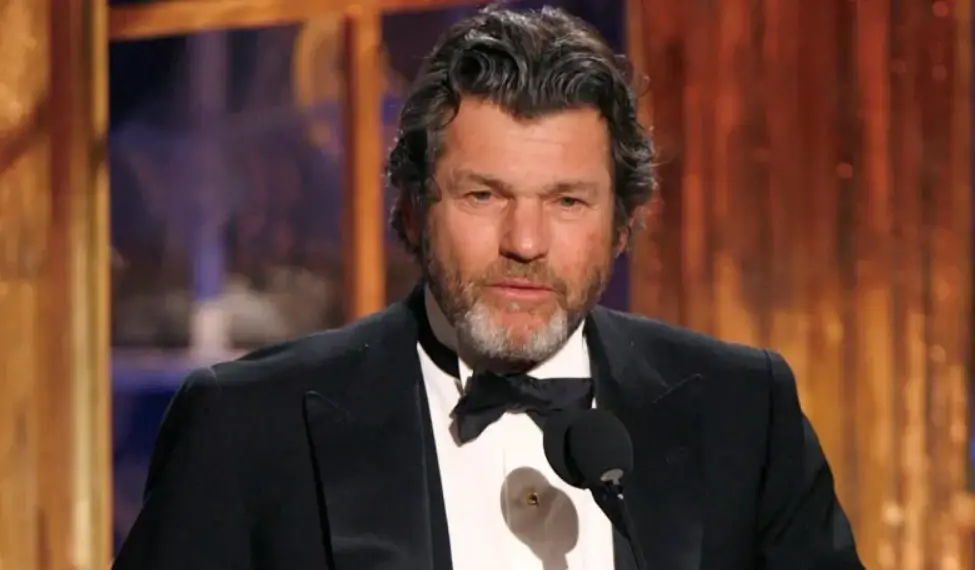
On Saturday, the Rock Hall issued a brief statement to the press: "Jann Wenner has been removed from the board of directors of the Rock & Roll Hall of Fame Foundation."
That announcement followed a wild 36 hours since a New York Times interview was posted where the Rock Hall co-founder and 2004 inductee made comments that were dismissive of Black and women artists.
Here is the exchange in the interview which led to the controversy:
There are seven subjects in the new book; seven white guys. In the introduction, you acknowledge that performers of color and women performers are just not in your zeitgeist. Which to my mind is not plausible for Jann Wenner. Janis Joplin, Joni Mitchell, Stevie Nicks, Stevie Wonder, the list keeps going — not in your zeitgeist? What do you think is the deeper explanation for why you interviewed the subjects you interviewed and not other subjects?
Well, let me just. …
Carole King, Madonna. There are a million examples.
When I was referring to the zeitgeist, I was referring to Black performers, not to the female performers, OK? Just to get that accurate. The selection was not a deliberate selection. It was kind of intuitive over the years; it just fell together that way. The people had to meet a couple criteria, but it was just kind of my personal interest and love of them. Insofar as the women, just none of them were as articulate enough on this intellectual level.
Oh, stop it. You’re telling me Joni Mitchell is not articulate enough on an intellectual level?
Hold on a second.
I’ll let you rephrase that.
All right, thank you. It’s not that they’re not creative geniuses. It’s not that they’re inarticulate, although, go have a deep conversation with Grace Slick or Janis Joplin. Please, be my guest. You know, Joni was not a philosopher of rock ’n’ roll. She didn’t, in my mind, meet that test. Not by her work, not by other interviews she did. The people I interviewed were the kind of philosophers of rock.
Of Black artists — you know, Stevie Wonder, genius, right? I suppose when you use a word as broad as “masters,” the fault is using that word. Maybe Marvin Gaye, or Curtis Mayfield? I mean, they just didn’t articulate at that level.
How do you know if you didn’t give them a chance?
Because I read interviews with them. I listen to their music. I mean, look at what Pete Townshend was writing about, or Jagger, or any of them. They were deep things about a particular generation, a particular spirit and a particular attitude about rock ’n’ roll. Not that the others weren’t, but these were the ones that could really articulate it.
Don’t you think it’s actually more to do with your own interests as a fan and a listener than anything particular to the artists? I think the problem is when you start saying things like “they” or “these artists can’t.” Really, it’s a reflection of what you’re interested in more than any ability or inability on the part of these artists, isn’t it?
That was my No. 1 thing. The selection was intuitive. It was what I was interested in. You know, just for public relations sake, maybe I should have gone and found one Black and one woman artist to include here that didn’t measure up to that same historical standard, just to avert this kind of criticism. Which, I get it. I had a chance to do that. Maybe I’m old-fashioned and I don’t give a [expletive] or whatever. I wish in retrospect I could have interviewed Marvin Gaye. Maybe he’d have been the guy. Maybe Otis Redding, had he lived, would have been the guy.
Wenner may not have "given a fuck," but the Rock & Roll Hall of Fame clearly did. Since 2020, under chairman John Sykes, the Hall of Fame has been trying to repair their "all-boys club" reputation that was forged under Wenner, His comments were clearly incendiary enough for them to sever the last remaining ties to their founder. (The Board vote was reportedly unanimous with the exception of longtime Nominating Committee chairman Jon Landau.)
Wenner's other institution, Rolling Stone, also tried to distance themselves from his comments:
Rolling Stone co-founder Jann Wenner has been ousted from his position on the Board of Directors of the Rock & Roll Hall of Fame Foundation. The news was announced on Saturday, following an interview with The New York Times, where he made widely criticized comments about Black and female musicians, alongside revealing other questionable editorial decisions.
Wenner is promoting his book, The Masters, which features interviews with influential artists, such as Bob Dylan, Mick Jagger, Pete Townshend, John Lennon, and Bruce Springsteen — none of the artists featured are female or non-white. In the Times interview with Wenner that published on Friday, he said that Black and also female musicians “didn’t articulate at the level” of the white male musicians in his tome.
…
Beyond the controversial comments about the artists that were and were not featured in The Masters, he also revealed during the interview that he allowed interview subjects to edit transcripts of their interviews prior to publication, which is not an accepted editorial practice and Rolling Stone does not allow interviewees to approve transcripts or final copy.
After being fired from the Rock Hall's Board of Directors, Wenner released an apology, “I totally understand the inflammatory nature of badly chosen words and deeply apologize and accept the consequences."
Those "badly chosen words" now provide the necessary context for understanding Wenner's legacy at the Rock & Roll Hall of Fame and beyond.
Women in the Rock & Roll Hall of Fame: An Update
In recent weeks there has been renewed public interest in the amount of women in the Rock & Roll Hall of Fame after influential writer Jessica Hopper, annoyed about the Hall's posts celebrating Women's History Month, tweeted the sobering statistics.
Do they tho? 719 inductees to the Rock N Roll Hall of Fame, only 61 are women. That's 8.48%. C'mon @rockhall, it's FUCKING GRIM BRO when yr doing worse than women-artists-on-country radio numbers (10%) and women headliners at major music festivals (13%) https://t.co/YvpCvwZ72o
— Jessica Hopper (@jesshopp) March 10, 2023
Hole frontwoman Courtney Love noticed the tweets and wrote a scathing indictment of the institution in an op-ed in The Guardian.
If so few women are being inducted into the Rock Hall, then the nominating committee is broken. If so few Black artists, so few women of colour, are being inducted, then the voting process needs to be overhauled. Music is a lifeforce that is constantly evolving – and they can’t keep up. Shame on HBO for propping up this farce.
If the Rock Hall is not willing to look at the ways it is replicating the violence of structural racism and sexism that artists face in the music industry, if it cannot properly honour what visionary women artists have created, innovated, revolutionised and contributed to popular music – well, then let it go to hell in a handbag.
The Pretenders' Chrissie Hynde followed with a public post on Facebook dismissing the institution as "establishment backslapping" and saying she didn't want to be associated with it.
With all of that as context, here are updated graphs showing the Rock & Roll Hall of Fame's record of inducting women.
First, showing the split among all individuals who have been inducted (all categories):

Next, showing the split between all-male acts versus artists with at least one woman (Performer category only):
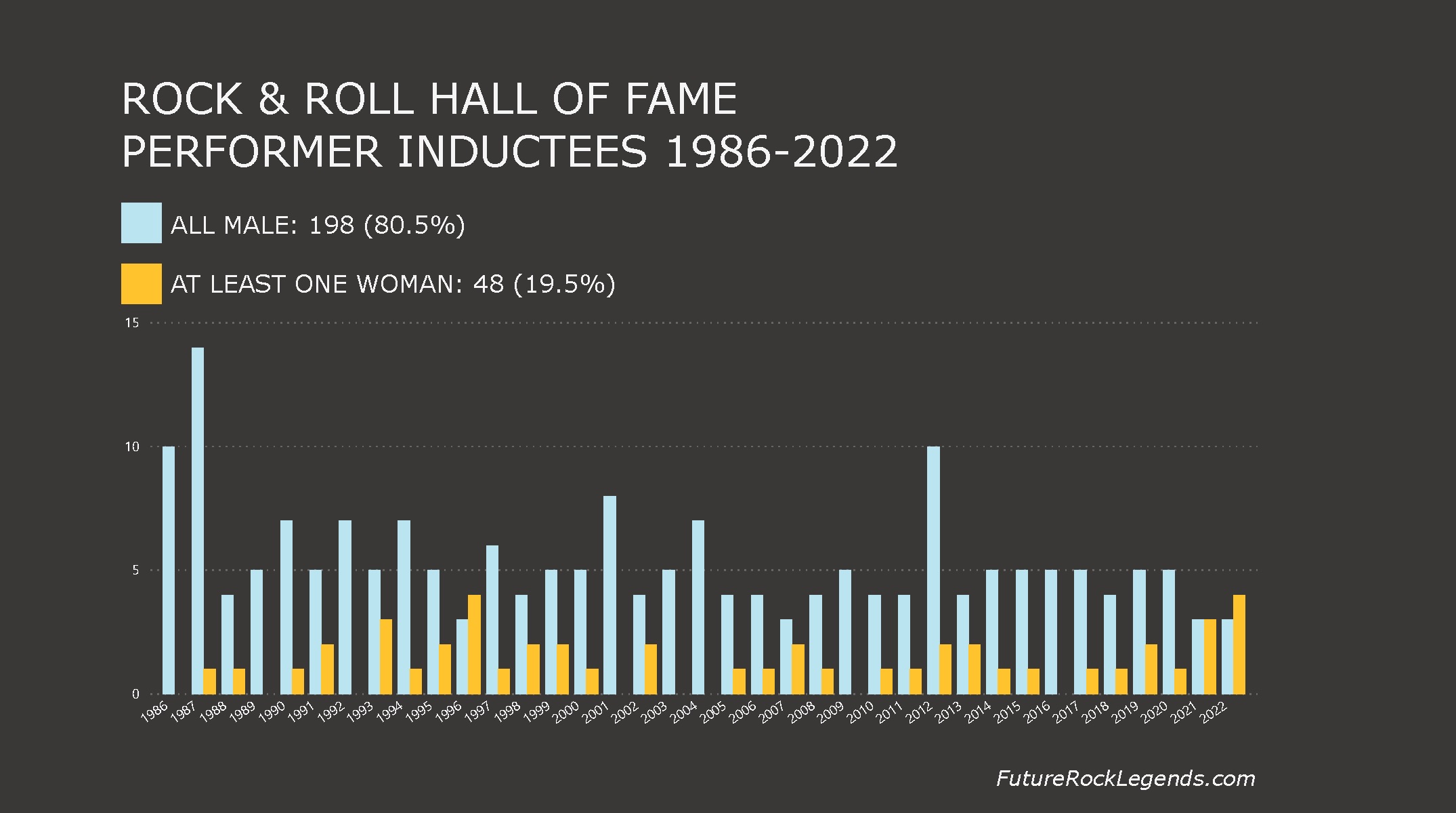
Finally, the numbers on the Rock Hall's Nominating Committee over the years:

As a point of reference, out of the 183 inducted members of the Country Music Hall of Fame, 25 are women (13.7%). Full list of the members of the Country Music Hall of Fame can be found at Future Country Legends.
The Country Music Hall of Fame inductees are selected by a secret committee run by the Country Music Association (CMA). It's unknown what the gender split is for those involved.
For more on the subject of Women in the Rock & Roll Hall of Fame, review our extensive archive on the subject dating back over a decade.
Women and the Rock & Roll Hall of Fame: Questions and Answers
The Rock & Roll Hall of Fame Nominating Committee will be meeting next month to craft the 2021 ballot. In recent years there has been mounting pressure from artists and critics to induct more women into the Hall of Fame. Let's ask and answer some questions regarding the numbers.
Q: How many women have been inducted into the Rock Hall?
A: Between 1986 and 2020, there have been 923 people inducted into the Hall of Fame, 70 are women (7.6%). The following graph shows how many men and women have been inducted each year.
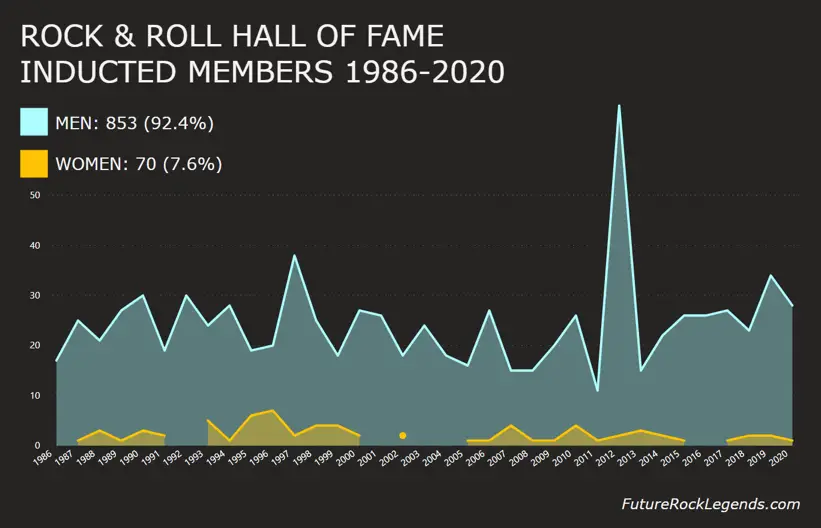
Q: Aren't those numbers misleading because for a female-fronted band like Blondie, that only counts as one woman and six men?
A: Only 15.4% of inducted artists include at least one woman. On average, the Rock Hall inducts about 1.5 artists with a woman per year versus 8 which are all-men.
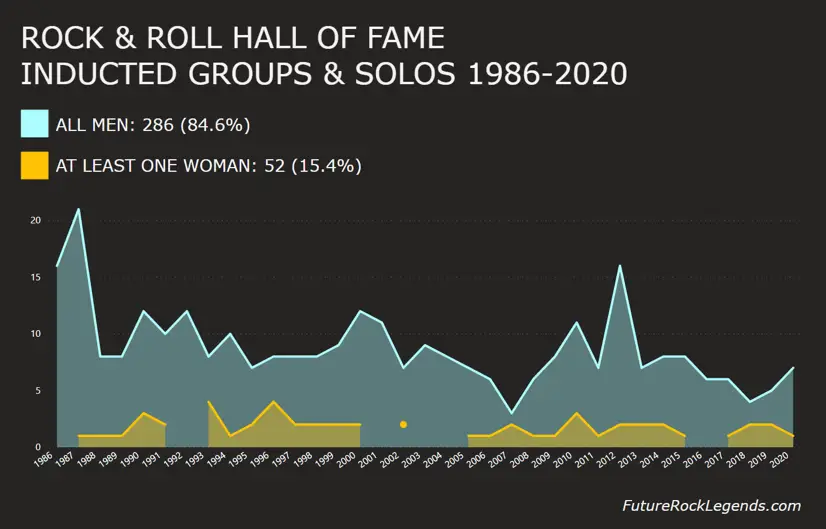
Q: What is with the gaps in the chart?
A: No women were inducted in the Rock Hall classes of 1986, 1992, 2001, 2003, 2004, and 2016.
Q: Greg Harris, the Rock Hall Museum President, said the low numbers are "a reflection of the amount of music that was made in the 50's and 60's, and I think we get more of an explosion of female performers especially in the 80's and 90's." So that must mean the female numbers are trending up?
A: The graphs above certainly don't show any upward trends overall. If you look only at inductees who began after 1980, five out of 23 have a female member (Stevie Nicks solo, Madonna, Janet Jackson, Whitney Houston, and Joan Jett), and all of them began their solo recording careers in the early 80s, which means there is no female representation for artists starting between 1985-1994. The 22% of artists from the 80s and 90s is higher than the overall 15%, but it's hardly an "explosion."
Q: How many women have been inducted twice?
A: In 2019, Stevie Nicks became the first woman to be inducted into the Rock Hall for a second time. Twenty-one men have been inducted twice, and Eric Clapton has been honored three times.
Q: Who decides which artists get inducted?
A: Some quick background on the induction system: The Rock Hall's process of determining its honorees begins with an appointed Nominating Committee consisting of roughly 30 members (artists, label executives, writers). That committee meets once per year and develops the performer ballot, which then gets sent to the 1000+ member Voting Committee, consisting of all living Hall of Famers plus an undisclosed list of others in the music industry (again, artists, writers, industry people). The five to seven artists who receive the most votes get inducted.
The Rock Hall has historically been secretive about who is on the Nominating Committee (and they still won't provide the list when asked), but we have been listing it on Future Rock Legends for years. While the Rock Hall argues that it's lack of women inductees is just a reflection of the gender imbalance in rock history, there is no such justification for allowing a system that they fully control to continue to have a gender imbalance such as this:
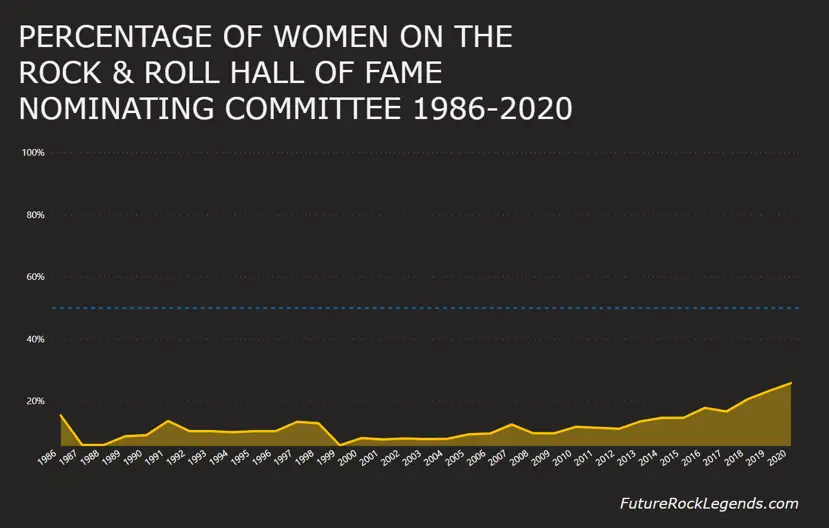
When you look at the above graph, which shows that just 11% of Nominating Committee members have been women over the years, it's hard not to think that the system has been rotten from the start, especially when some men in the group were abusers of women (or were apologists for it). Look at how overwhelming the numbers were between 1999-2006, and then scroll back up and look at how many women were inducted during that era:

The slow and steady gains in recent years looks positive, but it hasn't been enough to move the needle on the ballot or with the inductees. Just three women were nominated last year, and only Whitney Houston was inducted.
It should also be mentioned here that of the 74 people who have been listed as committee members which make selections in the Non-Performer, Early Influence and Sidemen categories, only three have been women (4%).
What should the Rock Hall do about any of this?
Well, if they don't do anything, it will be more of the same, despite Jann Wenner's insistence that in 20 years people will be complaining too many women are getting inducted. The 2020 class added twenty men to the Voting Committee and zero women, which just exacerbates the imbalance in the system.
A better option would be to listen to Rock Hall critics like Evelyn McDonnell. In her piece about the issue titled The Manhandling of Rock 'N' Roll History, she outlined three steps the Rock Hall needs to do to begin to right the ship:
- Flood the nominating committee and voting membership with more women.
- Reduce the voting power of members inducted as players in bands
- Nominate a shit ton of all-female bands next year.
This will be the first induction class under the new leadership of John Sykes, who took over as Chairman of the Board for the Rock Hall Foundation at the beginning of 2020. While Sykes inherits the Rock Hall's dismal record of nominating and inducting women, he can't be expected to correct 35 years of gender imbalance overnight, as the Hall of Fame's history has already been written. What Sykes does have full control over and can correct immediately is the gross inequity of the induction system itself. If Jon Landau, the Nominating Committee's chair, won't diversify his membership this year, he should be removed from his post. He has had 22 years at the helm and has clearly failed to bring equity of opportunity to the process, even after critical outcry.
The Nominating Committee is just one piece of the puzzle that needs to be fixed. It's safe to assume that the gender split of the Voting Committee is also heavily titled towards men. McDonnell's suggestion to dilute the voting power of bands is a great idea and should be implemented for the class of 2021. Combine that with a fresh look at the non-inductee voters to make sure there is a true diversity of voices casting ballots.
The Rock Hall has been predominantly run by white, male, baby boomers for its first 35 years. They built a museum and a cultural institution that tells the story of rock and roll as they experienced it, but it's an incomplete history. It's long past due to start a new chapter born from an equitable system.
Using "Women Who Rock" as a Predictor for the Rock & Roll Hall of Fame
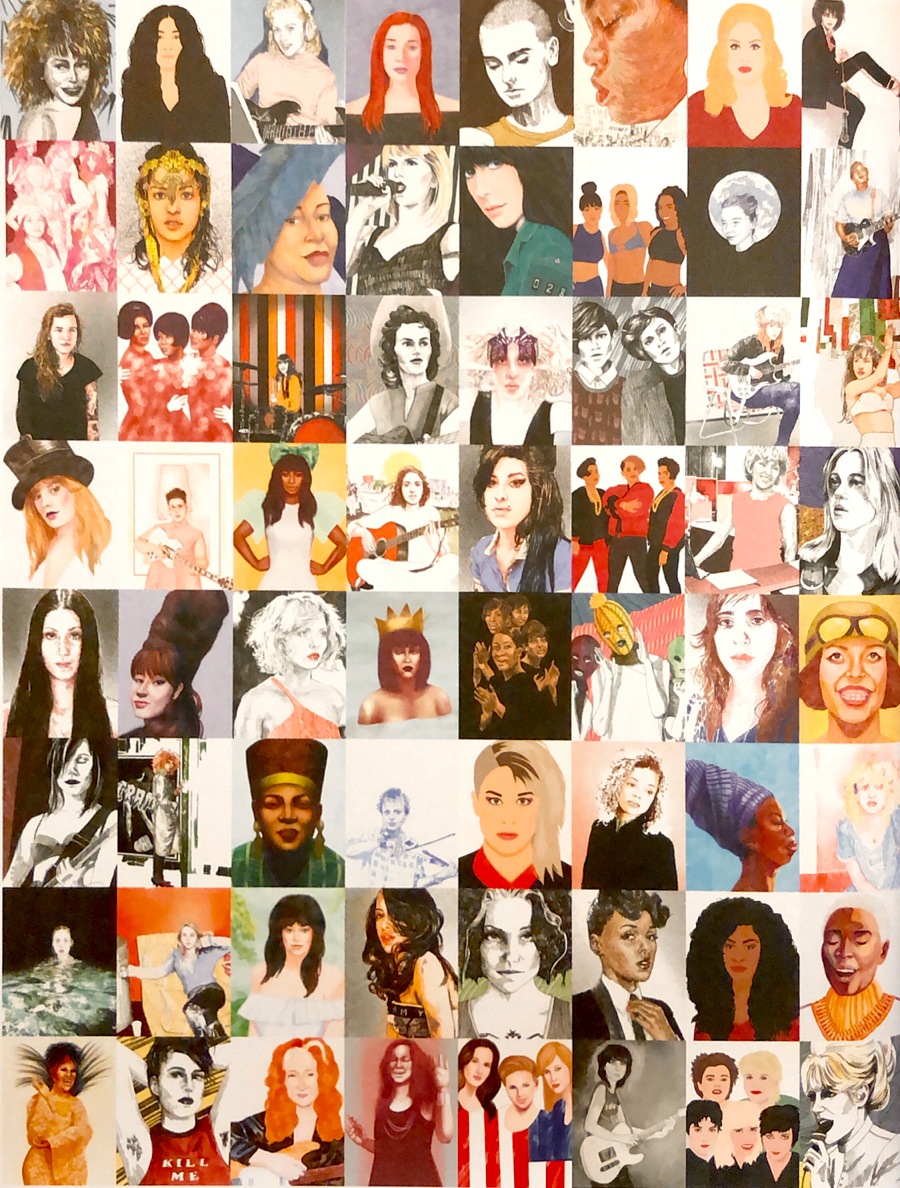
Journalism professor and former pop music critic Evelyn McDonnell is one of the most vocal advocates for properly recognizing the importance of women's contributions to rock music. Her essays regarding the Rock & Roll Hall of Fame's deficiencies in that area have led to a heightened awareness in the media and public that just 7.7% of inductees are women.
In 2018, McDonnell released her edited collection of essays, Women Who Rock, which celebrated the careers of over 100 artists, 30% of whom are already in the Rock & Roll Hall of Fame. While many of the remaining women highlighted in the book are clearly worthy of the Hall of Fame, most of those eligible haven't even been nominated due to the Rock Hall's flawed induction system.
Will this list predict who the next women inductees will be? The only three women who have been inducted by the Rock Hall since publication were featured in the book, Janet Jackson, Stevie Nicks, and Whitney Houston.
Here is the full list of women from the book (linked artists are not in the Rock & Roll Hall of Fame; Hall of Famers noted with their year of induction):
- Bessie Smith (1989)
- Sister Rosetta Tharpe (2018)
- Mahalia Jackson (1997)
- Willie Mae "Big Mama" Thornton
- Wanda Jackson (2009)
- Patsy Cline
- Nina Simone (2018)
- Odetta
- Joan Baez (2017)
- Carole King (1990 as Non-Performer)
- Celia Cruz
- Tina Turner (1991 with Ike Turner)
- Aretha Franklin (1987)
- Darlene Love (2011)
- Ronnie Spector (2007 with The Ronettes)
- Diana Ross (1988 with The Supremes)
- Dusty Springfield (1999)
- Marianne Faithfull
- Grace Slick (1996 with Jeffeson Airplane)
- Laura Nyro (2012)
- Janis Joplin (1995)
- Carol Kaye
- Cher
- Dolly Parton
- Mavis Staples (1999 with The Staples Singers)
- Joni Mitchell (1997)
- The GTO's
- Yoko Ono
- Patti LaBelle
- Linda Ronstadt (2014)
- Karen Carpenter
- June Millington
- Bonnie Raitt (2000)
- Betty Davis
- Suzi Quatro
- Chaka Khan
- Emmylou Harris
- Stevie Nicks (2019 solo and 1998 with Fleetwood Mac)
- Donna Summer (2013)
- Patti Smith (2007)
- Heart (2013)
- Debbie Harry (2006 with Blondie)
- Joan Jett (2015)
- Grace Jones
- Poly Styrene
- Siouxsie Sioux
- Kate Bush
- Alice Bag
- Chrissie Hynde (2005 with The Pretenders)
- Exene Cervenka
- Poison Ivy
- ESG
- The Go-Go's
- Laurie Anderson
- Diamanda Galás
- Cyndi Lauper
- Madonna (2008)
- Kim Gordon
- k.d. lang
- Whitney Houston (2020)
- Janet Jackson (2019)
- Salt-N-Pepa
- Sinéad O'Connor
- Angélique Kidjo
- Lucinda Williams
- L7
- Selena
- Queen Latifah
- Ani DiFranco
- Kathleen Hanna
- Courtney Love
- Liz Phair
- TLC
- Tori Amos
- PJ Harvey
- Gwen Stefani
- Björk
- Lauryn Hill
- Aaliyah
- Shirley Manson
- Sleater-Kinney
- Fiona Apple
- Missy Elliott
- Erykah Badu
- Neko Case
- Dixie Chicks
- Beyoncé
- Tegan and Sara
- Peaches
- Sharon Jones
- Laura Jane Grace
- Amy Winehouse
- M.I.A.
- Rihanna
- Ana Tijoux
- Taylor Swift
- Adele
- Janelle Monáe
- Lady Gaga
- Santigold
- Nicki Minaj
- Pussy Riot
- Brittany Howard
It should be noted that McDonnell's book is not meant to be a comprehensive list of women who are worthy of induction, because there are many others who should be considered.
10 Ways to Fix the Rock & Roll Hall of Fame
- Underrepresentation of nearly every genre of music among its inductees.
- Skepticism by fans and artists over the fairness and propriety of the induction system.
- Lack of diversity and conflicts of interest among the decision makers at the Rock Hall.
- The mishandling of inducted artists, which led to animosity and refusals to appear or perform at the Induction Ceremony.
- Unclear rules which get changed without logic or explanation.
Many of us who follow the Rock Hall have come up with a number of proposals which could help solve their chronic issues.
- Address the Backlog: This, more than any other issue, is the heart of the problem. The current induction system, which only inducts between five and seven performers each year, has produced a lengthy list of artists who are arguably worthy of induction, but can’t break through. Every year in which more worthy artists become eligible than are inducted, the list just gets longer. By arbitrarily limiting the number of inductees, the Hall created a system where it is guaranteeing that worthy artists will never get a chance to be honored. The Rock Hall is currently at the bottom of a hole they have been digging for over 20 years. They’re not going to get out of it by increasing the number of annual inductees by one or two per year. More creative measures are needed. Some potential solutions:
- On the Hall Watchers podcast, Eric and Mary proposed moving the ceremony to a two night event which would allow the Hall to induct more artists without compromising the induction ceremony format. For its 25th anniversary, the Rock Hall staged a two-night all-star concert at Madison Square Garden, so they have some experience with that format.
- The Hall could also move to a system of themed induction classes, where a dozen artists could be enshrined around a common theme.
- This upcoming ceremony will be the Rock Hall’s 35th, which provides an opportunity for the Rock Hall to have super-sized classes every five years.
- Change the entire ceremony structure to allow for large induction classes. This would require shorter speeches and performances, but it would give the Rock Hall flexibility to induct significantly larger classes.
A change like this can’t happen without upending the expectations of what a Rock Hall induction looks like (but again, this is the hole that the Rock Hall dug itself).
- Create a Veteran’s Committee: Years ago, Tom Lane offered up this proposal modeled on other Sports Halls of Fame which have a system meant to catch worthy inductees who were left behind for one reason or another.
As John Sykes takes steps to keep the Rock Hall up with the times, it would behoove them to create a new category that fills in the historical gaps in the rock and roll canon. The Rock Hall has been trying to play catch up for 35 years now, and there are still foundational artists who can’t even get nominated, and it’s not even at the expense of newly eligible artists who also can’t get on the ballot.
Listen to Criticism: Over the past year, much of the conversation about the Rock Hall has revolved around the underrepresentation of women. Instead of taking a dismissive attitude about the issue, listen to your critics and engage in the conversation. Take the opportunity to improve your institution and create some goodwill with the public. Burying your head in the sand isn’t going to work.
Become Transparent: The Hall has been proudly opaque since its inception which has led to conspiracy theories and allegations of corruption and conflicts of interest. The Hall could turn that around under its new leadership by publishing their rules, providing independent accounting of votes (or publishing the numbers), reveal the members of the Nominating and Voting Committees, and making those in charge available to the media. As non-profit entities, the Rock Hall Foundation and Museum should have a minimum amount of transparency about the core functions that support their mission.
Stop the secret inductions: We highlighted a couple of examples of artists who were quietly inducted after the fact. This type of behavior creates distrust with the public and doesn’t properly honor those who get inducted.
Eliminate or Fix the Singles Category: A lot has already been written on this subject, so we won’t rehash it here, but it’s unwise to create Rock Hall categories that don’t have a clearly defined purpose and are left to the whims of one individual.
Term Limits for Nominating Committee Members: The Country Music Hall of Fame utilizes a system where Nominating Committee members are appointed to three year terms. Each year, one third of the members get replaced. After serving out their term, members are eligible to return for another three years, but only after sitting out for at least one term.
While there would be some institutional knowledge lost in this system, it would greatly increase the number and diversity of voices in the room. Members who distinguish themselves would be invited back after three years, while others would just be let go.
Rethink the Voting Committee: There has always been a tension between the will of the Nominating Committee and the results produced by the 1000 or so members of the Voting Committee. The NomCom nominates worthy artists over and over and yet they keep getting bypassed by the voters. While it seems fair on the surface, a system where each inductee automatically becomes a voter has created a population of voters who tend to favor artists closest to themselves, which magnifies the imbalance. One way to improve the system would be to give inductees with multiple members a fraction of a single vote. So each member of The Cure would get 1/10th of a vote as opposed to the 10 votes they currently get. By minimizing the voting power of large bands, it would provide a more representative power to each solo inductee.
Change the Voting System: With the significant backlog of worthy artists, getting on the Rock Hall ballot is an achievement unto itself. Why not expand the list of artists who meet that threshold by greatly expanding the number of nominees well past the 15-20 that have been nominated in recent years? There is a lot of frustration from the Nominating Committee about not wanting to put forward similar artists in the same year, but a ballot of 50 names would open up a new world of possibilities. Likewise, when the Voting Committee gets the ballot, allow them to vote for as many Hall of Fame worthy artists as they like. Currently they are restricted to voting for only five, which creates strategic voting that leaves clearly worthy artists on the outside. There are so many different ways to vote that are superior than the current system, the Rock Hall should start experimenting immediately. (The Hall should consult with inductee Krist Novoselic, who has been an advocate for proportional representation in politics.)
- Give the Fan Vote some actual power or just eliminate it: The Hall of Fame seems to love the fan engagement from the online fan poll, but most fans have no idea how little it (officially) matters in the actual tally (the fan vote is cumulatively about 0.1% of the total ballots). Provided the Rock Hall can stage an online poll that can’t be rigged, the results should at least be worth 5% of the total. Otherwise you’re just taking advantage of passionate fans’ time.
There are many other ways that the Rock Hall could be improved, but the most important thing for John Sykes is to just get started.
Women on the Rock Hall Nominating Committee
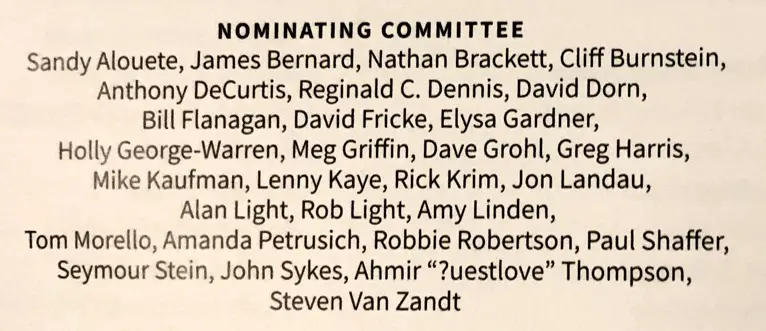
The real problem involving women and the Rock and Roll Hall of Fame — the central, intrinsic, original sin part of the hall, worse even than its insider-y nature and inconsistency — is the lack of women on the nominating committee. In recent years, there have been five or six on a committee that ranges from 30 to 45 members, and that’s a high mark for the hall.It is appalling, sexist, unforgivable, and f*cking ridiculous. All the men on the committee — particularly critics like Anthony DeCurtis, David Fricke, Bill Flanagan, and others who would be expected to note such nonsense in other institutions — should be called out for not having the guts to stand up and say they won’t participate in such a preposterously sexist organization. But of course, this timidity is no doubt what has made them, from the perspective of organization leaders like Jann Wenner, ideal nominating-committee members.
I don’t know what effect a balanced gender representation on the nomination committee might have. It might make for more women nominees, it might lead to a more sophisticated appreciation of dance music, or it might keep the hall just as insider-y and in-clubby as it is now, only with more women involved. Any of those outcomes is acceptable; that’s not the point. The makeup of the committee is the hall’s major scandal.
During his appearance on SiriusXm for the nominee announcement, Rock Hall Foundation president Joel Peresman said that the Nominating Committee basically remained unchanged from last year, but a “woman from Los Angeles” was added to the group. That will increase the number of women on the Committee to 23% (seven women, compared to 23 men) In the early 2000s, that number was around 6%.*
Incoming chairman of the board, John Sykes, has pledged to diversify the Rock Hall Foundation’s board with “more women, more people of color and [become] a board that reflects the artists that are now being inducted.” The Board currently has 26 members, two of whom are women (8%). Sykes hasn’t directly called for more diversity on the Nominating Committee, but he seems to be setting the tone for how he wants the institution to move forward.
* - It should be noted here that the Rock & Roll Hall of Fame will not release a list of Nominating Committee members to journalists who ask, and prefers the names not be made public.
Women, Rock & Roll, and the Hall of Fame

[Janet] Jackson is one of only two women being inducted into the hall this year, out of 37 inductees, including the members of the five all-male bands being inducted. The other woman is Stevie Nicks. During the 34 years since the hall was founded by Jann Wenner and Ahmet Ertegun, 888 people have been inducted; 69 have been women. That’s 7.7 percent. The problem is spreading.
...
The Rock Hall is the most obvious offender in what I’ll call the manhandling of musical history. Manhandling is akin to, and often — as with the Rock Hall — intersects with, whitewashing. Manhandling pushes women out of the frame just as whitewashing covers up black bodies. People of color account for 32 percent of Rock Hall inductees, a far better figure than for women, but still not representative of the enormous role African Americans and Latinx people have played in American popular music.
McDonnell makes the case that the gender disparity was baked in from the first induction class and takes aim at one of the Rock Hall’s founding members:
[Buddy] Holly and [Chuck] Berry were both among the first 16 acts inducted in the Rock Hall, in 1986. All their fellow inductees were male. Built on such grotesquely imbalanced footing, the institution may never get itself right. After all, its main instigator was Ahmet Ertegun, an admittedly legendary records man who treated women abominably, according to Dorothy Carvello’s 2018 memoir Anything for a Hit. Carvello is a music executive who began her career working for Ertegun at Atlantic. Ertegun subjected her to crude sexual harassment and once fractured her arm in anger. The Rock Hall named its main exhibition hall after Ertegun. How can this ever be a place where women feel welcome, let alone safe? Just as universities have removed from buildings and fellowships the names of film executives who gave them money, such as USC renaming their Bryan Singer Division of Critical Studies, the Rock Hall should remove Ertegun’s name from the building and from the annual industry executive award that bears his name. It’s an award that has never been given to a woman.
...
Guys like Ertegun, who died in 2006, reportedly manhandled in the workplace, in addition to creating the Cleveland shrine to gender inequity. Carvello’s book documents in scandalous detail how he and other executives created a boys’ club environment where women had to either pretend to be one of the boys, betraying their sisters, or trade sex for promotion. In Ertegun’s world, women were not allowed to step up; they were stepped on. Having systematically excluded and oppressed women from the business of making music, Ertegun and his cronies at the Rock Hall then carved that exclusion into stone by essentially writing them out of history, year after year after year. When women do get let into the Rock Hall boys’ club, it is on the arms of men: Carole King is there for her songwriting with Gerry Goffin, not as the woman who recorded numerous hit songs herself, including those on the record-smashing album Tapestry. Tina Turner was inducted alongside her abusive ex-spouse Ike.
McDonnell also points out that the induction system created by the Rock Hall perpetuates the gender imbalance every year because each inductee becomes a voter, who then “vote in their friends and heroes, who tend to be men.”
Those of us who criticize the Rock & Roll Hall of Fame do so because despite its flaws, the institution does matter. McDonnell feels the same way:
It’s tempting to just say so what. I would like to not care about what institutions such as the Met and Hall of Fame do. They are essentially shrines to white men created by white men, so of course, they honor white men. But they pretend to serve the public — and in the Met’s case, it is in part a publicly funded institution. The Hall of Fame and its associated museum have enormous cultural power, writing in stone the historical importance of individuals in a way that no other institution or publication or organization does. They also create real economic benefits for culture workers. Being inducted into the Rock Hall doesn’t just look good on your resume, it helps sell records and tickets. Most importantly, these institutions provide inspiration — role models — for future generations. And if the only women you’re going to see receiving awards on that stage at the Barclays Center are Janet Jackson and Stevie Nicks, would you, if you were a little girl, go pick up a guitar?
It should be noted here that the Rock & Roll Hall of Fame Museum is also supported by taxpayers to the tune of over $125 million since 1995.
McDonnell offers a course of action for the Rock Hall:
There are three things the Hall of Fame can do to rectify that imbalance: 1. Flood the nominating committee and voting membership with more women. Six out of 29 members of last year’s nominating committee were women; the notoriously tight-lipped hall has not revealed this year’s committee members. 2. Reduce the voting power of members inducted as players in bands (so, say, the five dudes in Def Leppard each get one fifth of a vote). 3. Nominate a shit ton of all-female bands next year.
Evelyn McDonnell also edited last year’s Women Who Rock anthology.
Steve Miller Exposes the Rock & Roll Hall of Fame and Calls for a Change in Leadership

The whole process is unpleasant. The whole process needs to be changed from the top to the bottom. It doesn’t need to be this hard. There is nothing fancy going on out there that requires all of this stuff.They need to get their legal work straight. They need to respect the artists they say they’re honoring, which they don’t. I don’t have any of my paperwork signed, I have no licensing agreements with these people. They’re trying to steal footage. They’re trying to make me indemnify them.
When they told me I was inducted they said, “You can have two tickets - one for your wife and one for yourself. Want another one? It’s $10,000 - sorry that’s the way it goes.” I said, “I’m playing here. What about my band? What about their wives?” They make this so unpleasant.
They came this close - [publicist asks Miller to wrap it up]
No, we’re not going to wrap this up - I’m going to wrap you up. You go sit down over there and learn something. Here’s what you need to know. This is how close this whole show came to not happening because of the way the artists are actually being treated right now. So I’ll wrap it up.
In a separate interview with AP, Miller had further thoughts:
It wasn’t very overwhelming. It was kind of like a lazy kind of night with a bunch of fat cats at the dinner table.It’s not a real pleasant experience, to tell you the truth. The reason it isn’t is because they make it so difficult for the artists. I think it’s time for the people running this to turn it over to new people, because it doesn’t need to be this difficult.
I don’t know why I was nominated for this, because i’ve said this about the Rock and Roll Hall of Fame for 30 years and I don’t get along with the people who run it. When I found out about it, I felt like I was in a bullshit reality TV show.
Miller also said, "My fans take it seriously. I really didn't want to show up... You tell me what the hell is the Rock and Roll Hall of Fame, and what does it do besides talk about itself and sell postcards?”
Some of Miller’s criticism of the institution came out during his eight minute acceptance speech on stage:
And to the Rock and Roll Hall of Fame, I’d thank you for your hard work on behalf of all musicians. And I encourage you to keep expanding your vision. To be more inclusive of women and to be more transparent with your dealings with the public. And most importantly, to do much more to provide music in our schools.
If you follow the dealings of the Rock & Roll Hall of Fame, none of this is news. We have been documenting the Rock Hall’s issues with women, transparency and treatment of artists for years.
The @Rock_Hall seems to have the unique ability to simultaneously honor and an insult an artist's career. #DeepPurple #GNR #KISS #Heart
— Future Rock Legends (@futurerocklgnds) December 22, 2015
Artists have been complaining about the Rock Hall for decades too. In 1997, Neil Young boycotted the ceremony for similar reasons that Steve Miller outlined above:
Young, who was inducted as a member of Buffalo Springfield, boycotted the performance because of a dispute with the rock hall over its refusal to provide him with enough free tickets to bring his family to the $1,500-a-plate dinner.In a letter to the rock hall, VH1, Atlantic Records founder Ahmet Ertegun and his Buffalo Springfield bandmates, Young also said he was upset with the rock hall's decision to sell broadcast rights to VH1, feeling that featuring the ceremony on TV commercialized and cheapened it.
”The VH1 Hall of Fame presentation has nothing to do with the spirit of rock 'n' roll," wrote Young. "It has everything to do with making money. Inductees are severely limited in the amount of guests they can bring. They are forced to be on a TV show, for which they are not paid.”
Let’s also not forget the Sex Pistols letter.
What makes Steve Miller’s statements so important is that he decided to step on the neck of the Rock Hall on the night he was being inducted. Usually any bad feelings get pushed to the side on a night filled with so much positive energy from your peers and fans, but Miller knew that his words would carry the most impact at that moment.
The question now is, will this actually change anything? The Rock Hall has been mismanaging artist relations for years, which has led to numerous lost opportunities for induction ceremony reunions (including two this year alone). When will the Rock Hall board wake up and realize that this isn’t working on nearly every level? The Rock & Roll Hall of Fame Foundation’s primary responsibilities are running the induction process, organizing the induction ceremonies and raising money. How much more failure in each of these areas is the Rock Hall willing to endure?
Steve Miller said, “I think it’s time for the people running this to turn it over to new people, because it doesn’t need to be this difficult.” We agree.
E-Rockracy: Public Image, Damaged: The Rock Hall's Public Perception Problem
As the stars converge and the hype builds for the 31st Rock & Roll Hall of Fame induction ceremony in Brooklyn tonight, it's important not to lose sight of an inescapable fact: By any measure, the Rock Hall is an American institution with a tarnished public image. Sad to say, but it's lost hearts and minds. When tickets for your annual watershed gala event are going on StubHub for $12, and the simulcast of said event at the museum isn't sold out, well, those are bad omens.
There's an acute public perception problem here, and the reasons go beyond why your favorite band isn't in the hall yet; in fact, let's please put those reflexive, tiresome, moody blues to rest for now. In considering the Rock Hall gestalt, there are two entities that feed off each other. First there's the museum in Cleveland, which opened in 1995 and is an exceptionally-curated music fan pilgrimage. Secondly and most significantly, there is the organization that spearheaded the museum, The Rock and Roll Hall of Fame Foundation, NYC-based and formed in 1983 by the late Ahmet Ertegun, Jann Wenner, Seymour Stein, Jon Landau, and others to recognize achievement in popular music.
That mission sounds simple enough. In fact, the early years, marked by the privately-held induction ceremonies at the Waldorf-Astoria in New York City, were a relatively non-controversial, celebratory breeze. Elvis! Chuck Berry! Bob Dylan! Aretha! The Beatles! But as decades have gone on, and as Wenner has dubiously claimed "all the no-brainers" are inducted, it seems that myriad issues have cropped up that threaten to irrevocably damage the very idea of "The Rock and Roll Hall of Fame." These issues include, but are not necessarily limited to, transparency, communication, gender equality, credibility, common sense, and conflicts of interest:
- Transparency - Most people that follow the hall closely, as well as casual observers/everyday rock fans, get a sense that most major Rock Hall decisions are being made behind closed doors. This is a non-profit that is driven by donations, but the institution seems to act with impunity and zero accountability. Does anyone on the outside, let alone donors, know what's going on? Sure, financial numbers get disclosed. But missing is the basic information that would actually matter to the populist masses the Hall is purportedly courting to buy memberships and tickets to the museum/induction ceremonies. The most corrective measure the Hall could take toward transparency would be to disclose the vote counts that decide who gets inducted. A press release is issued, and news outlets and social media are abuzz on announcement day, but it seems no one truly questions the results. (Does anyone truly believe that Steve Miller got more votes than Janet Jackson? That's not to take sides in support of either, but most fan polls outside the Rock Hall's bot-corrupted fan vote had Janet well ahead, and you'd think there would be at least some parallel).
- Communication - The fact that most people believed that N.W.A. would perform at the induction ceremony tonight, only to be highly disappointed yesterday when they saw Ice Cube's interview in the New York Times saying they weren't performing due to disagreements with the organizers, is a prime example of the Rock Hall dropping the ball when it comes to communication. How long was this known? It certainly wasn't in the Hall's best interest to disclose that fact. Going broader in terms of the 2016 ceremony, why are there only five performer inductees this year? Previous years have had quite a few more. A sixth slot could have gone to a deserving artist like Yes. Again, there are no real answers from the Hall, just speculation across the board that maybe they're trying to shorten what have been admittedly long ceremonies.
- Gender Equality - There's not a single female inductee this year, not even a single announced presenter tonight that is female. Furthermore, per the essential Rock Hall resource Future Rock Legends (futurerocklegends.com), "Of the 547 Rock Hall voters we have on our unofficial list, 9.3% are women." Expanding the voting body to include more women is urgent, crucial, and ridiculously overdue.
- Credibility - The Hall-run, official fan vote for the 2016 induction class was an abject disaster. Overtaken by bots and registering an inhuman 160,905,154 votes, it's exhibit A for the Hall to come up with a more secure, credible fan voting system. (And yes, Chicago fans, the point is taken that you are passionate, and that you voted a bunch. But you didn't vote 37 million times, as the official Rock Hall fan vote would have us believe.) This needs to be fixed before the next set of nominees is announced.
- Common Sense - When choosing which band members to induct (or not induct at all, as in tonight's Steve Miller "sans Band" scenario), the committees apparently need to do more research, consult the bands, and use some common sense. In the case of Deep Purple, vocalist Red Evans is being inducted, but bassist Nick Simper was excluded, which is confounding as they played on the same records and were in the band at the same time. Yet every drummer of the Red Hot Chili Peppers was inducted? Inconsistency at best.
- Conflicts of Interest - The late Bert Berns is being given the Ahmet Ertegun Award for Lifetime Achievement tonight, an honor that is apparently determined not by voting but via the unilateral decision of a nomination committee. Steven Van Zandt and Paul Shaffer are producing a Broadway musical about Bert Berns, and they are both on such a committee. The red flags being raised here, justifiably so, are conflicts of interest, and the overarching sense that the Rock Hall insiders are just going to do whatever they want. Berns, a storied '60s producer, record man and songwriter, has accomplishments that have more than earned him this honor, but it's too bad his induction has this shadow of impropriety over it.
In closing, the Sex Pistols' Johnny Rotten, upon learning of his band's induction, fired off a burning missive to the Hall in 1996, calling it a "piss stain." He added, "Your anonymous as judges but your still music industry people (sic)." Maybe Rotten's was among the first hearts and minds lost.
That doesn't mean the Rock Hall can't course-correct and win back those that still believe in a credible, well-executed, and balanced recognition of musical achievement. Fixing these issues isn't just the right thing to do; it may even secure the Rock Hall's long-term future.
by Eric Layton -- originally posted on E-Rockracy on 4/8/2016
Women in the Rock and Roll Hall of Fame
We were inspired to delve into this further after reading this recent tweet:
Now, we have done some rough calculations on this subject previously, and 4% seemed awfully low, so we went ahead and counted up all of the inductees (including every inducted member of groups).Are you kidding me? Only 4% of the inductees @rock_hall are women??! What can be done about that? #Cleveland
— Folk 'N Great Music(@FolkNGreat) August 26, 2012
| Induction Category | # of Hall of Famers | # of Women | % Women |
| Performer | 565 | 48 | 8.5% |
| Early Influence* | 50 | 6 | 12% |
| Non-Performer | 44 | 3 | 6.8% |
| Lifetime Achievement | 7 | 0 | 0% |
| Sideman / Musical Excellence | 19 | 0 | 0% |
| Total | 685 | 57 | 8.3% |
Some additional data points:
- Of the 186 performers inducted, 31 include at least one woman (16.7%).
- There are 98 duos and groups that have been inducted in the performer category, accounting for 494 of the inductees. Of these, there are 36 women from 19 groups.
- Of the 88 individuals inducted in the performer category, there are 12 women (13.6%).
- There are no women in the “Clyde McPhatter Club” -- Hall of Famers inducted multiple times.
- In 1986, 1992, 2001, 2003 and 2004, no women were inducted.
It’s difficult to find a similar institution to compare to the Rock Hall. (For example, the Baseball Hall of Fame only has one woman inductee!) Another music industry benchmark might be the Grammy Awards. Their marquee award, Album of the Year, has included a woman 31% of the time (17 out of 54). This issue isn’t exclusive to music. In the U.S., only 5% of the art on display at museums is made by women.
After all of the “Women Who Rock” publicity last year, many of us thought that might inspire a more female-centric 2012 induction ballot. When the finalists were announced, five of the fifteen were women, a relatively high percentage by Rock Hall standards. But after the voting, and when it was all said and done, out of the 69 trophies handed out at the Induction Ceremony in Cleveland this year, just two went to women.
* - We haven’t been able to fully document all of the inducted members of Early Influence groups. This may be where the discrepancy lies between our total number of inductees. The Rock Hall lists 681 and we counted 685. The percentages of women remain largely unaffected either way.
Courtney Love Unhappy with Rock and Roll Hall of Fame
Last week, the Rock and Roll Hall of Fame announced its annual list of inductees. The news was followed by the annual list of grievances and complaints about those choices in the music business. This year, however, the opposition included a particularly high-profile and vitriolic voice, Courtney Love's.Well, Michael Stipe has been inducted into the "idiotic" Hall of Fame, and he's Love's daughter's godfather, so that's at least one Hall of Famer that she knows.. . .
Some in the music industry were upset that punk-rock and female acts were not represented in the winners' circle, but Ms. Love had her own ax to grind. Evidently not a fan of the New York Dolls, Black Sabbath or Lou Reed [nominees who weren't inducted that year], she lambasted the Hall of Fame in a telegram: ''How dare you fools not put Lynyrd Skynyrd, Patti Smith, or AC/DC in your Hall of Fame. Damn you to the darkest belly of the underworld. Stop.''
She goes on to demand that the items belonging to herself and her husband, Kurt Cobain, that are in the possession of the Hall of Fame's museum in Cleveland be returned: ''Any of my stuff you stole, I want back immediately. Stop. This includes any of mine or Kurt's clothes, guitars, or debris that you scavenged for. Stop. I hope that no one I know is ever inducted into your idiotic 'Hall of Fame.' ''
One wonders what will happen in 2011, when Nirvana, Cobain's old group, will most likely be inducted into the Hall of Fame.
Ms. Love concludes her telegram: ''You are a sham and you deserve Bush. Stop. He probably has the same taste in music as you.''
An employee for the Rock and Roll Hall of Fame said the sentiments expressed in the telegram captured the true spirit of rock 'n' roll.
For the record, Nirvana can't actually be inducted prior to the 2014 Induction Ceremony and Hole won't be eligible until two years after that.
